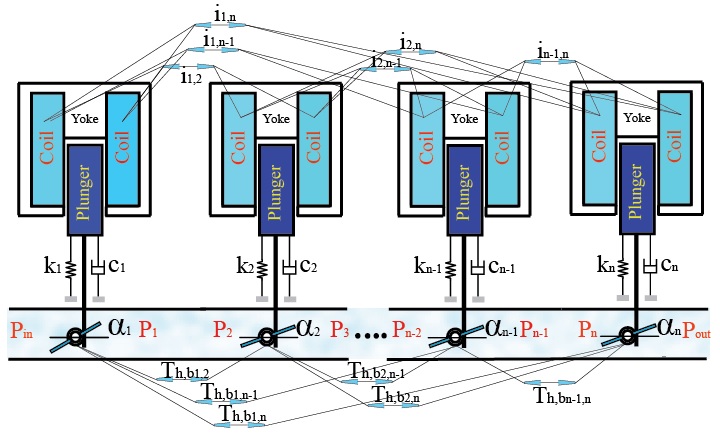
The US Navy has been on modeling, dynamic analysis, and optimization of electromechanical sets
particularly the flow control network to be used in chilled water systems for cooling purposes.
These critical systems have drastically revealed sensitive roles to affect optimal performances of
other units including radar, sonar, and automation devices. Either military incidents or technical
malfunctions of different components caused harmful behaviors of the whole network resulting in
the failure of a large-scale system. The USS Cole flow line is one of the catastrophic examples of
the inefficient network design which has dramatically failed resulting in losing many of expert
crews in addition to the significant amount of financial costs (over $13 million) imposed to
restore the whole system.
Surprisingly, the efforts carried out have mostly studied and developed a single set of the
electromechanical valve system by neglecting its interactions with other elements operating instantaneously.
The same problem would exist for other applications such that a comprehensive
coupled analysis of the flow control network lacks and this project is mainly on developing
reliable, optimal, and stable interconnected sets. Increasing the scale of the network reveals the
necessity of such secure and energy efficient models in that the energy sources are too limited
due to improper consumption paradigms, mismanagements, and operating the inefficient networks
designed and controlled. Such an inefficient design can potentially be a result of an isolated analysis
exposing the whole network in the danger of instability which has been observed in the practice.
The motivation of this research work obviously roots on yielding high fidelity coupled models, nonlinear
dynamic analysis, optimization, and adaptive and real-time control of the flow network to
avoid such serious concerns stated.
Network-Based Analysis: The most of electromechanical systems used in the flow control lines
have separately been studied by neglecting the interconnections imposed of other sets. From another
aspect, the linearization method, as one of the simplest practices, is widely being utilized in
many of analytical investigations particularly for the systems with a higher level of complexity and
coupling. The results of both the isolated- and linearized-based analyses may expectedly be valid
within a narrow domain of operation leading typically to the significant inaccuracy and unreliability
of the analytical efforts. It has specifically been shown that the studies to be carried out too close
to the equilibria, generally speaking, do not consider the effects of the significant nonlinearities
resulted from each set and other units' couplings. A network-based nonlinear analytical model
will be instead developed in the course of this research to be expected in yielding a clear map of
dynamic couplings of all units in order to capture the whole possible harmful behaviors and also
to design, operate, and control the network efficiently.
Network-Based Optimization:The optimization of any network in particular the dynamically coupled ones has received much attention to yield the most efficient design and operation of all sets with respect to a lumped amount
of energy used. Typically two optimization schemes, namely, ''Optimal Design'' and ''Optimal
Operation'', have been on modifying the design and operation of the actuation and mechanical
parts, respectively. The optimal design would seek the bounded and efficient electromagnetical
parameters in the couplings with the flow and mechanical loads, which are being investigated here,
to reduce the amount of energy consumed in the whole network. The bounds would be subsequently
determined with respect to the interconnected nonlinear dynamic analysis we will carry out to force
the network to be operated in the secure domain.
The optimal design is expected to yield an energy efficient network but would not be sufficient.
The optimal operations of all valves will hence be examined to find optimal paths minimizing
the lumped amount of energy used in the optimally designed sets. It will be of great interest to
observe the effects of valves' operational couplings, through the media tapped between them, on
the optimization task. From another aspect, the interacting valves to be optimized operationally
are expected to reveal significant effects on the dynamics of electromagnetical elements via the
nonlinear network-based model.
Network-Based Control: Previous work on smart valve networks made use of local feedback
controllers, designed based on models of a single actuated valve set, to improve the stability and
performance of the whole network. One drawback of employing local controllers is the harmful
behaviors caused by neglecting high interactions among the actuated valves as well as lack of analytical
coupled models. Furthermore, we have low confidence in the accuracy of the mathematical
models for smart valve systems based on which the local controllers are to be designed.
To tackle these problems, we will develop adaptive and nonlinear feedback control algorithms for
the network of interconnected actuated valves to asymptotically stabilize desired trajectories in the
presence of uncertainties and disturbances. The proposed algorithms deal with high interactions
in the large-scale network, and are practical for real systems. Furthermore, they are model-based
and deal with full-dimensional complex models, and can be easily transformed from one network
to another with minimal trial and error.
Network-Based Experimental Testbed: An experimental work we will carry out in order to
validate the nonlinear model couplings, measure some of the most critical parameters of each unit
including the flow loads and pressure drop across each valve, and also to implement the network-based
control algorithms. We have demonstrated that the flow loads in addition to the pressure
drop of each valve remarkably affect its electromechanical dynamics and therefore, they would
be expected to play the same key roles for other units. Technically speaking, the electromagnetical
sections of the whole network will be subject to slight changes of the critical flow parameters
through the media tapped and constraints. We will need to monitor such complex couplings with
the aid of an experimental testbed. The optimally designed and operated network needs also to be
examined experimentally confirming the feasibility of such a stable and optimal complex system.
|